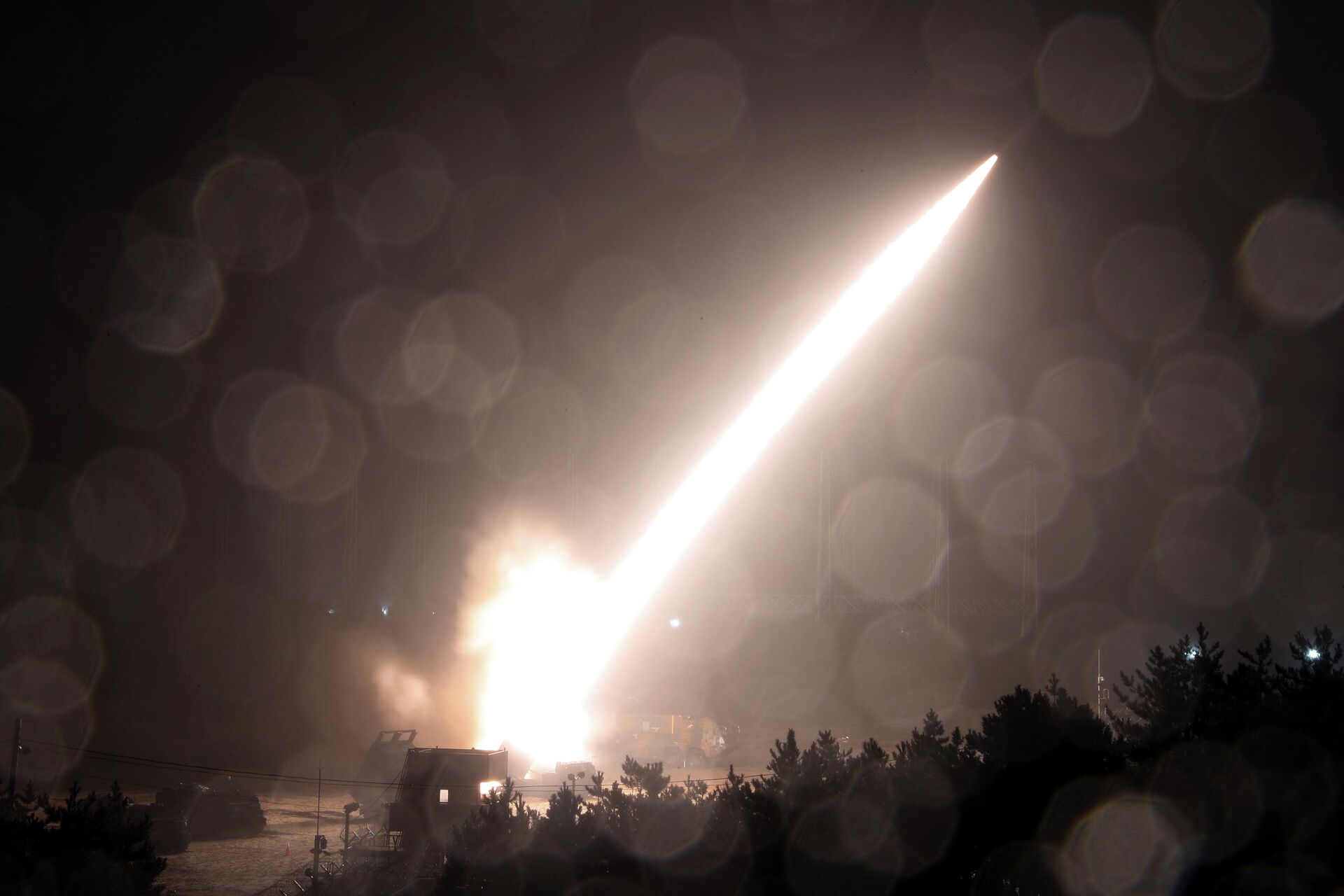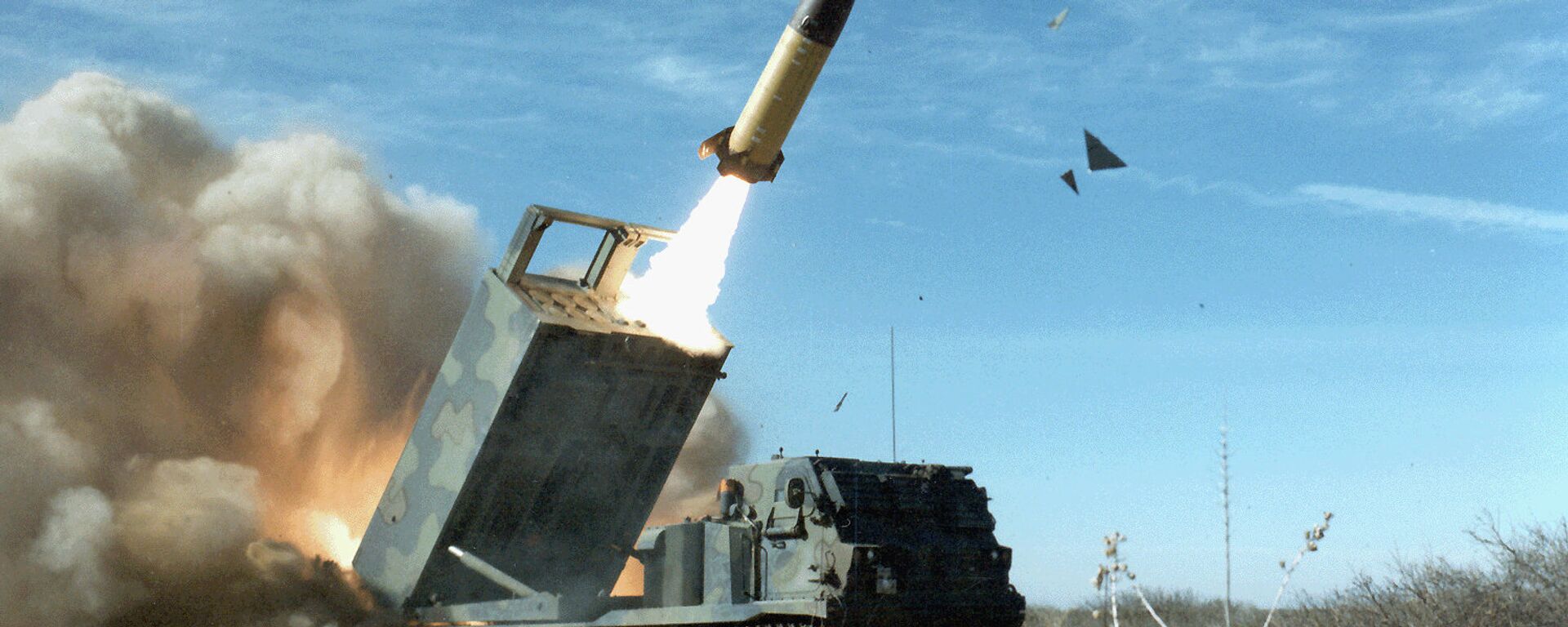Russian Air Defenses Well-Adapted to Taking Out Aged ATACMS Missiles US Gave to Ukraine
18:49 GMT 18.10.2023 (Updated: 18:55 GMT 18.10.2023)
Subscribe
While Ukraine has received a new longer-range ballistic missile from the US, the weapon is of limited use due to its age, against which Russian defense systems are well-adapted, an expert told Sputnik. The weapon might cause problems for Russian forces, but its impact will be limited.
The US has confirmed that it transferred MGM-140 Army Tactical Missile Systems (ATACMS) to Ukraine, which were then used to strike Russian forces in Berdyansk, on the Sea of Azov. The short-range surface-launched ballistic missile is fired from the HIMARS, which the US previously supplied to Ukraine along with missiles inferior to the ATACMS.
The US had previously hesitated to give Ukraine the longer-range ATACMS over fears that Kiev would use them to strike inside Russia, further escalating the conflict.
Commenting on the missile’s delivery, Russian President Vladimir Putin called it “a mistake” that would “prolong the agony” for Ukraine.
Sputnik spoke with Dmitry Kornev, founder of the MilitaryRussia.ru portal, to understand what the ATACMS is capable of, how Ukraine is likely to use the weapon, and how it will affect Russian forces engaged in the special operation in Ukraine.
How Will Kiev Use the ATACMS?
“We already see how and where Ukraine can use these missiles,” he said. “It can be assumed that Ukraine will use them in those areas where it is conducting or plans to conduct active operations.”
“In the case of Berdyansk, it is the southern direction from Zaporozhye. Where will future missiles be used? The question is still complex, but most likely, somewhere around there, because due to the weather and simply out of the desire to do at least something before winter, the Ukrainian Armed Forces will continue to make some attempts to counterattack,” Kornev said.
“The US provided the Ukrainian Armed Forces - apparently, again, we don’t know the details - but apparently they provided the oldest version of the missiles. ATACMS, which was produced in the 1990s, has a range of approximately 160 kilometers and has a cluster warhead. That is, these are not the best ATACMS missiles. But it is possible that the United States was afraid, in general, of it being used at its maximum range - that is, against targets in Crimea.”
“Most likely, the United States will continue to supply these missiles depending on if the Ukrainian Armed Forces use the first batch of these missiles effectively and without negative PR,” he predicted.
Why Did US Give Kiev its Oldest Missiles?
“As stated in the United States, the range of the ATACMS missiles transferred to Ukraine is 165 kilometers,” he said. “ATACMS missiles exist in several versions. That is, the first versions of ATACMS missiles, from which they were produced until the 1990s, had a range of about 160 kilometers. Later versions of the missiles had different ranges: 250, 270, 300 kilometers. Under the name of ATACMS, there are about five to six, maybe even more, missile variants.”
“They have different types of combat units, they have different ranges, they have features in their guidance systems. It is clear that the United States, apparently, will not yet supply Ukraine with the most modern missiles, for fear of losing technological leadership in this area.”
“Most likely, the point here is that they decided to start with old missiles and see how the Ukrainian Armed Forces can handle them,” he explained, adding that the US could give Ukraine more advanced missiles in the future, which have GPS guidance instead of the inertial guidance used in the older weapons.
“Plus you need to understand that the United States, from a purely mercantile point of view, are interested in getting rid of old stocks - that is, those missiles that they themselves definitely don’t need,” he added.
Prior to 2019, US ground-based tactical missiles were limited to ranges of less than 500 kilometers by the Intermediate-Range Nuclear Forces (INF) Treaty. After the US unilaterally shredded that treaty in 2019, it announced that a successor missile to the ATACMS, the Precision Strike Missile (PrSM) would have its range extended beyond 499 kilometers.
New Danger, But Not 'Miracle Weapon'
Kornev noted that ATACMS poses a new threat to Russian front-line aviation units, to which Russian forces will have to adapt.
“In general, yes. We see that the first use of ATACMS missiles was directed against front-line aviation airfields with helicopters. ATACMS missiles with cluster warheads can effectively target targets such as airfields. Accordingly, all helipads, airfields, some aviation units, warehouses, transport hubs - all this may come under attack from ATACMS missiles,” he said.
“Such impacts would be extremely unpleasant for aircraft. And yes, this will lead to the fact that the Russian Armed Forces will be forced to move the bases of front-line aviation further from the line of contact. This, in turn, will lead to an increase in the time it takes for front-line aviation to appear at those points where it is needed at the moment,” he explained. “Their reaction time will decrease, there will be excess consumption of fuel, because you will have to fly longer, and you will have to introduce such a concept as duty [patrols] in the contact zone. It will become more difficult in any case.”
However, the military expert noted that “miracle weapons do not exist” and Ukrainian forces armed with ATACMS can’t change the course of the conflict by themselves.

Army Tactical Missile System or ATACMS missile is fired during a joint military drill between U.S. and South Korea
© AP Photo / South Korea Defense Ministry
“The secret of the parties’ success is in the integrated use of heterogeneous forces, in interaction, in the presence of a strategic plan, in the availability of human resources. If we take everything together, then only this can lead to one or another military success for either side,” he said.
“That is, the ATACMS missiles themselves, appearing on the line of contact, will not lead to an unconditional victory for the Ukrainian Armed Forces. But if, in addition to ATACMS missiles, all other listed factors are met … well, yes, then this will be one of the components of the possible success of the Armed Forces of Ukraine. But so far we do not see such a situation. This is just another factor. That's all there is to this confrontation.”
Can Russian Air Defenses Handle ATACMS?
Kornev noted that the ATACMS is broadly similar to Russia’s Iskander missile, which was introduced as a response to the ATACMS. Accordingly, Russian air defense systems from that period and later are capable of downing ATACMS missiles.
“These are medium-range complexes of the Buk type. Moreover, all modifications of Buks can operate on ATACMS missiles,” he noted. “These are complexes of the Tor type. At the final stage of the flight, they can also work on ATACMS missiles, because the Tor’s range is not the longest. Pantsir-type complexes, again at the final stage, can also work against ATACMS missiles at long and medium ranges, of course, and the S-300 and S-400 complexes, of course, can hit ATACMS missiles.”
“Of course, we must understand that when using such missiles, they will most likely be used in groups. For example, the attack that we saw on Berdyansk, apparently, three ATACMS missiles were used, plus, probably, other types of missiles were also used in the same attack. Accordingly, there is a dispersion of air defense systems, forces, air defense systems and a group strike is more difficult to shoot down.”
“Plus ATACMS, well, let’s just say, is not the stupidest missile. It can perform anti-missile maneuvers. In general, at the first stage this will be a difficult goal, but our systems are able to shoot down such missiles - technically, they are capable of this. It will be necessary to develop methods and share these methods between air defense units and master them. And, in fact, it will just be combat work. After a while, there will be nothing supernatural in the defeat of a [ATACMS] missile,” he said.
Turning to the missile’s weak points, Kornev said the biggest problems for the Ukrainians will be political, not technical.
“If the United States rations the number of ATACMS missiles for the Ukrainian Armed Forces, then, of course, this will cause problems,” he said. “That is, technical problems, all missiles have them, but it is unlikely to greatly affect the results of their use.”





